Sathya Sai Baba maintains that the Ramayana, the Mahabharata incl. Bhagavad Gita state historical fact
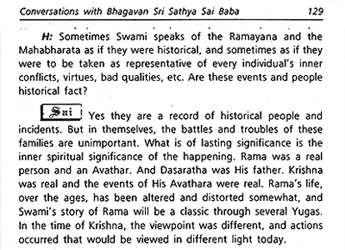 In one of many interviews Sathya Sai Baba
gave to Dr. John Hislop, he confirmed in no uncertain terms that the classical scriptures of India (Ramayana and Mahabharata) are literally true as the quote from Conversations
with Bhagavan Sri Sathya Sai Baba by Dr. John Hislop (Prashanthi Books and Publications Trust, Puttaparthi. new ed. p. 129 old ed. p. 155). See scan here:-
In one of many interviews Sathya Sai Baba
gave to Dr. John Hislop, he confirmed in no uncertain terms that the classical scriptures of India (Ramayana and Mahabharata) are literally true as the quote from Conversations
with Bhagavan Sri Sathya Sai Baba by Dr. John Hislop (Prashanthi Books and Publications Trust, Puttaparthi. new ed. p. 129 old ed. p. 155). See scan here:-
Among many other incredible Sathya Sai claims are the following:-
1) that he is an avataric incarnation who previously incarnated as Vishnu, Krishna, and Rama. He claims he was 84 years of age at the time of the Mahabharata war (Summer Showers at Brindavan 1978,
page 58)
2) that the date of the Mahabharata war was 3138 BC. (Summer
Roses on the Blue Mountains 1976. p. 85f)
3) that he performed Krishna's miracles as described in the Ramayana, defeating the many-headed snake, Seshu, multi-locating his body simultaneous in the rasa dance with six thousand gopis (i.e. cowgirls) and much more! (Sathya Sai Speaks Vol. 26, pps. 27-29)
4) that as Lord Rama and did what is related in the Ramayana, defeating
demons (rakshakas), flying in the Pushpak aircraft - powered only by mantras', banishing his
wife, killing Ravana and so on.
5) that he is the Deity of all Deities: he said in 1968: "This is a human form in which every Divine entity, every Divine principle, that is to say, all the names and forms ascribed by man to God, are manifest... You are very fortunate that you have the chance to experiences the bliss of the vision of the form, which is the form of all gods, now, in this life itself." (Sathya Sai Speaks Volume VIII. page 99f)
Comment: These accounts may be believed by many innocent, naive and credulously believing Hindus who think Sathya Sai Baba genuinely represents their religion, but neither historians nor the world community at large will ever do so.
Here are some of Sai Baba's comments showing he believes literally in the sheer myths of Indian scriptures:-
Dr. J. Hislop: “Sometimes Swami speaks of the Ramayana and the Mahabharata as if they were historical, and sometimes as if they were to be taken as representative of every individual’s inner conflicts, virtues, bad qualities etc. Are these events and people historical fact?”
Sai “Yes they are a record of historical people and incidents… Rama was a real person and an Avathar. And Dasaratha was His father. Krishna was real and the events of His Avathara were real. Rama’s life, over the ages, has been altered and distorted somewhat, and Swami’s story of Rama will be a classic through several Yugas.”
(Conversations with ‘Bhagavan Sri Sathya Sai Baba’ by Dr. John Hislop – 155 new ed. 129 old ed.)
5) That he is also no less than the avatar Lord Vishnu, come again to save humanity, as predicted in the mythology of the Srimad Bhagavatha.
So What about giants?
Seems the Kentucky creationists have left out an important era of prehistory (perhaps they are too ignorant?). That is, if Sathya Sai Baba’s divine testimony is anything to go by!
Dr. John Hislop once asked him: “Swami once mentioned that if we could see Rama today we would be much surprised at His appearance.”
Sai replied “In the age prior to that of Rama, people were accustomed to measure the distance from the fingertips to the elbow. At that time, the norm for the height of a person was 14 times the measurement… In the Threta Yuga, the age of Rama, the norm for height had reduced to seven times the distance of fingertip to elbow. For the Kali Yuga, the multiple is three and one half.”(Conversations with Bhagavan Sri Sathya Sai Baba by J. Hislop, page 129f)
Comment: Fingertip to elbow measures 19 ins. So Rama was 14 time 19 inches high which = 266 inches.
That’s 22 feet, 2 inches high! (Rama and Co. could have been prehistory’s Harlem Globetrotters!)
Oh yes, the first aeroplanes – India flew them over 3000 years ago!
Dr. Hislop also asked: “In those days they had aeroplanes, did they not?” Sai answered: “The first was ‘Pushpak’. The one Ravana used to kidnap Sita.” (Comment: Sita was, of course, Rama’s wife…which also means, according to Sathya Sai Baba’s claims, his former wife in his former body).
Hislop asked: “Did they use atomic energy for power?” Sai answered: “No. By the power of mantra the plane would fly. Mantras were used to shoot arrows. The arrows were worshipped to make them effective. When Arjuna heard of Krishna’s death, he forgot all mantras and was powerless.” (Conversations with Bhagavan Sri Sathya Sai Baba by J. Hislop, page 130f)
See Sai Baba's diverse claims that he was Krishna and is now incarnated as Sathya Sai Baba
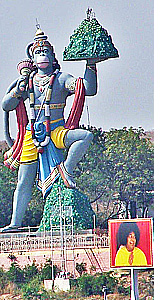 Sathya Sai on Hanuman as a real figure who did what was claimed!
Sathya Sai on Hanuman as a real figure who did what was claimed!
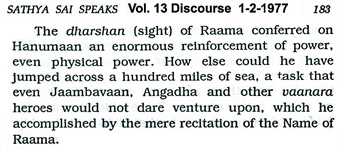

Hanuman, presented as almost the greatest devotee of the mythical King Rama, was a 'monkey man' who supposedly jumped dozens of miles - and also carried a whole mountain so a healing herb could be picked from it. And he makes very clear that this is no myth for Sai Baba, who claims he was Rama once, and Hanuman his trusted servant!
Among the extremely tall and massive garish statues at the Hillview Stadium, Puttaparthi, there is a monster 'Indo-kitch' representation of Hanuman holding a mountain aloft. The money for all these useless artefacts comes from donations intended to help the poor, needy, analphabets, the diseased, ill and suffering peoples and for many world visitors these are white elephants which typify the usual Indian extravagance and waste among such enormous poverty and suffering.
That Hanuman is described variously as a 'monkey' or a 'monkey-man' and is pictured with a monkey face and a tail makes this story unbelievable to anyone with a modicum of knowledge of paleontology.More likely the myth is based on the perception of them by Arian Hindus who came from the North and met with the indigenous Dravidians who were (and still are) darker and who were free and physically agile as 'noble savages' who lived closer to the wild (as of course do do monkeys).
Two conflicting versions of a scriptural story:
In the Mahabharatha is a story which Sathya Sai Baba told on two occasions in very different versions. In the first
instance it was presented as if it were factual:
A concise resumé of most of version one of the rambling tale firstly:
"The cowherd Maaladhaasa who was determined to see the Lord and prayed
to the "black Lord riding on a white bird". Due to his fasting and
prayer, the Lord did at last appear to him, but as an old Brahmin, but he
was not black and there was no bird. So the cowherd asked the Brahmin to come
next day again so he could get the village pandit to say whether he was the
Lord himself. The pandit laughed and the whole village turned out next day
to see this Brahmin, but only the cowherd Maaladhaasa could see him. He was
ridiculed... 
Let Sathya Sai Baba take up his rambling story here: "At last, he got
so enraged they he walked up to the old Brahmin and gave him a whacking blow
on the cheek, saying "Why don't you show yourself to all?" That
blow changed the entire scene. Krishna appeared in resplendent robes, smiling
face, captivating form and the white bird. As the astounded villagers were
recovering from the amazement, the heavenly chariot (Vimaana), floated down
from the sky and Krishna asked Maaladhaasa to sit inside it. Then, with the
Lord by his side, Maadlahaasa rose up and soon was out of sight." ('Faith
that made the lord manifest' (Sathya Sai Speaks Vol 7, pps 7f)
So the reader is supposed to take this to heart... Sathya Sai Baba is that
same Lord, very hard to recognise, and we all should compare ourselves to
the astounded and amazed villagers!!
The second version is reported in a book one of the early Western devotees, Alvin Drucker, produced with the aid of an Indian translator from talks to his students in Telugu in 1984 which Druckerrecorded. ( Discourses
on the Bhagavad Gita - p. 32 first ed.).
In this version, a poor boy cowherd was told by a pundit Harikathadas that Lord Vishnu
was traditionally represented as "dark/complexioned, wore a traditional
white mark on his forehead, and rode on a white eagle". The story dwells on all the boy's exaggerated penances and prayers and concludes by Vishnu manifesting himself
in the form desired by the cowherd.
The
discrepancy between the two 'tales' is typical of many of Sai Baba's stories and alleged
accounts of ancient events to which he claims to know or have attended! My old friend and elderly editor of The Sanathana Sarathi monthly journal, former journalist
V.K. Narasimhan, related to be how he felt bound to correct errors and mix-ups that Sathya Sai Baba frequently made in his discourses. Narasimhan translated and edited these for nearly 2 decades. He told me how he was worried that he would be 'brought
to book' (as it says my notes recorded at the time) by people who might hear the recorded
tapes and compare them to his altered versions. He said that these versions were personally endorsed by Sathya Sai Baba each month. Another similar incident about whch Narasimhan also told me was - while interpreting a Sai Baba talk to Englishabout Kalidasa's famous play concerning Shakuntala and a wedding ring,
Sathya Sai mixed up the story by making the ring a gift from Shakuntala to the king. However,
in the original, the gift was from the king to Shakuntalah. Narasimhan told me he had whispered
this to Sai Baba, but was told to translate it just as he had said it in Telugu, that is, the incorrect version.
Apparently it did not seriously affect the plot of the story.
Comment: The above, where even a once acclaimed journalist falsifies fact to make Sathya Sai Baba look better, indicates the the sloppy and calculating nature of all reporting on Sathya Sai Baba by those who dare not challenge him on the slightest point.
Return to index menu
 In one of many interviews Sathya Sai Baba
gave to Dr. John Hislop, he confirmed in no uncertain terms that the classical scriptures of India (Ramayana and Mahabharata) are literally true as the quote from Conversations
with Bhagavan Sri Sathya Sai Baba by Dr. John Hislop (Prashanthi Books and Publications Trust, Puttaparthi. new ed. p. 129 old ed. p. 155). See scan here:-
In one of many interviews Sathya Sai Baba
gave to Dr. John Hislop, he confirmed in no uncertain terms that the classical scriptures of India (Ramayana and Mahabharata) are literally true as the quote from Conversations
with Bhagavan Sri Sathya Sai Baba by Dr. John Hislop (Prashanthi Books and Publications Trust, Puttaparthi. new ed. p. 129 old ed. p. 155). See scan here:-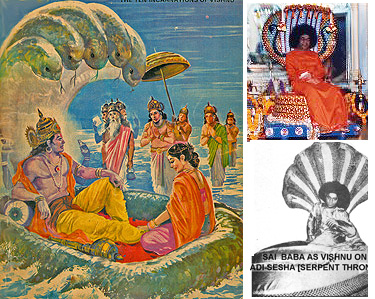

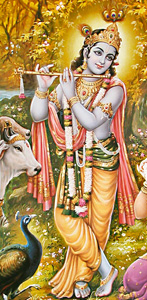

 Sathya Sai on Hanuman as a real figure who did what was claimed!
Sathya Sai on Hanuman as a real figure who did what was claimed! 

